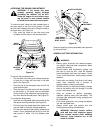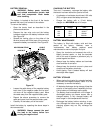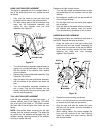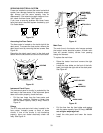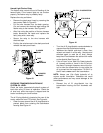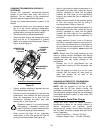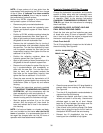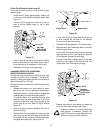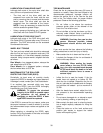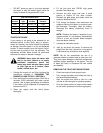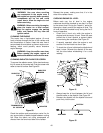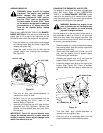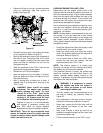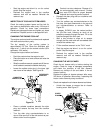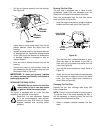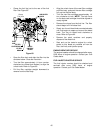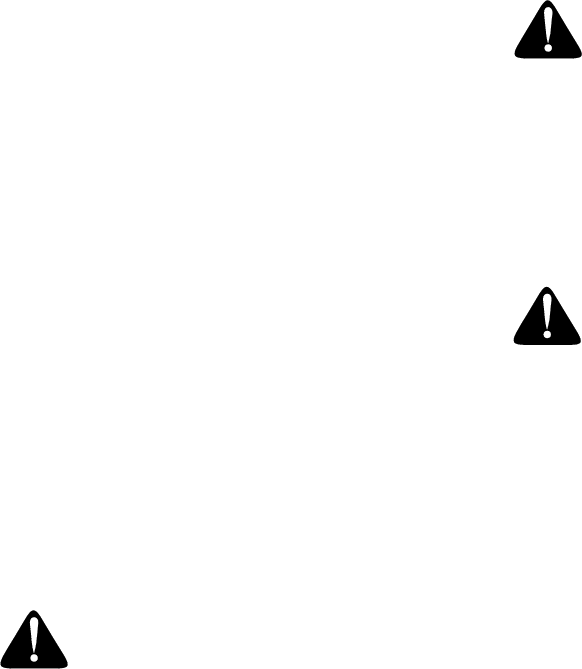
38
LUBRICATION OF MAIN DRIVE SHAFT
Lubricate both ends of the main drive shaft after
every 50 hours of operation as follows:
• The front end of the drive shaft can be
accessed from under the hood, and the rear
end by removing the six screws and the center
fender cover. The drive shaft can also be
accessed from the underside of the tractor.
NOTE: It may be necessary to rotate the drive
shaft to access the grease fittings.
• Using a pressure lubricating gun, lubricate the
drive shaft with Cub Cadet 251H EP grease.
LUBRICATION OF FWD DRIVE SHAFT
Lubricate both ends of the FWD drive shaft with
Cub Cadet 251H EP grease after every 50 hours of
operation. The FWD drive shaft can be accessed
from beneath the tractor.
WHEEL BOLT TORQUE
The front and rear wheel bolts should be retorqued
after the first ten hours of operation and every 100
hours thereafter, or if the wheel assembly has been
removed. Using a torque wrench, retighten the bolts
as follows:
Rear Wheels—In a staggered pattern, retorque the
rear wheel bolts to 80 ft. lbs.
Front Wheels—In a staggered pattern, retorque
the front wheel bolts to 55 ft. lbs.
MAINTENANCE OF THE ROLLOVER
PROTECTIVE STRUCTURE (ROPS)
Periodically (at least every six months) visually
inspect the ROPS for damage and loose fasteners.
If damage is noted, contact your Cub Cadet dealer.
If an accident has occurred which may have
damaged the ROPS, have the ROPS thoroughly
inspected by your Cub Cadet dealer.
WARNING: To ensure the structural
integrity of the ROPS to provide opera-
tor protection, do not attempt to
straighten or weld the ROPS. A dam-
aged ROPS should be replaced.
If the ROPS is removed for any reason, make sure
the proper hardware is used to reinstall it, and that
the recommended torque values are applied to the
fasteners.
When replacing or reinstalling the ROPS, apply
Loctite
®
242 to the threads of the bolts and torque
the bolts to 65 to 70 ft. lbs.
TIRE MAINTENANCE
Check the tire air pressure after every 50 hours of
operation or weekly. Keep the tires inflated to the
recommended pressures. Improper inflation will
shorten the service life of a tire. See the tire side
wall, or the Tire Inflation chart, for proper inflation
pressures. Observe the following guidelines:
• Do not inflate a tire above the maximum
pressure shown either on the sidewall of the
tire or the Tire Inflation chart.
• Do not reinflate a tire that has been run flat or
seriously under inflated. Have a qualified tire
mechanic inspect and service the tire.
WARNING: Servicing tires can be dan-
gerous. Whenever possible, trained
personnel should service and mount
tires.
If you must service the tires, observe the following
safety precautions to avoid an injury or fatality:
• Make certain the rim is clean and free of rust.
• Lubricate the flanges of the rim and beads of
the tire with soap solution.
WARNING: When seating the beads,
never inflate a tire over 35 PSI. Inflat-
ing a tire with unseated beads beyond
35 PSI could break the bead or rim with
sufficient explosive force to cause a
serious injury.
• Inflate the tire to seat the beads. If the tire
beads have not seated at or before 35 PSI,
allow the tire to deflate. Reposition the tire on
the rim, lubricate the tire beads and rim flanges,
and reinflate until seated - up to a maximum of
35 PSI.
• After the beads have seated, adjust the infla-
tion pressure to the recommended operating
pressure.
• Do not use a damaged rim, or attempt to repair
a rim by brazing, welding, or pounding out.
• Make certain the jack used to raise the tractor
has a weight capacity adequate for lifting the
tractor.
• Place the tractor on a firm, level surface and
position jack stands to support the raised
tractor while repairing tires.



